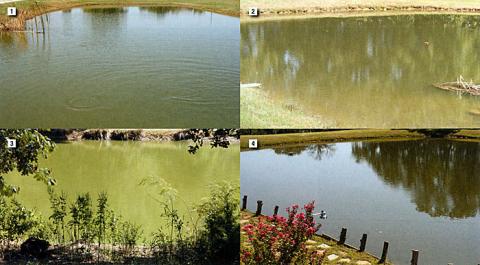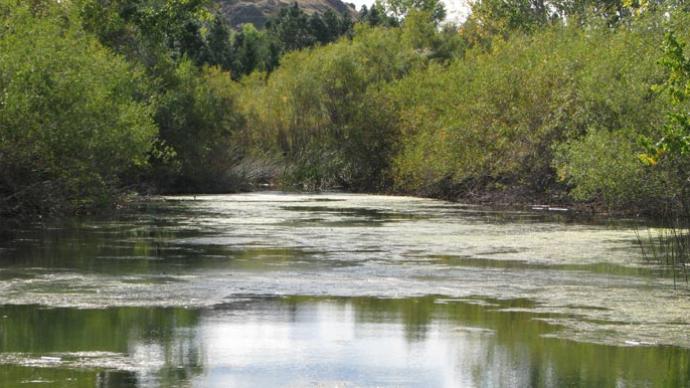
Long time Pond Boss subscriber and client of mine, Stan Graff, from Dallas, called and asked a really good question recently.
"I hear biologists and pond managers say the phrase, 'read the bloom' over and over. Exactly what does that mean?"
Great question.
Complex answer.
Let's give it a go, though. In different parts of the country, pondmeisters are advised to fertilize their ponds. Pond fertilizers are high in phosphorus, the most limiting nutrient in most fishing ponds. By dissolving appropriate amounts of fertilizer into the water column at temperatures above 55 degrees each spring, a plankton bloom is started.
There are two basic reasons to fertilize a pond.
One reason is to create plankton, a microscopic food chain for newly hatched fish. You see, baby fish, called 'fry' get their food from the yolk of what was their egg. After they absorb the yolk, they must eat. They have no stores of body fat, yet. Think how tiny their mouths are...smaller than the head of a straight pin. Plankton feeds baby fish.
The second reason is to decrease light penetration in the water column. A plankton bloom clouds the water and turns it a pretty shade of green. Decreasing sunlight penetration into a pond effectively stops the growth of rooted submersed aquatic plants. Aquatic plants need sunlight, food and the 'right' temperature. Take away any one of those 'big three' and plants won't grow.
Graff had a motive for asking his question. During the hottest part of last summer, one of his lakes developed a heavy planktonic algae bloom. It became so dense so quickly, he lost fish. Not once or twice...but three times.
By the time anyone on his ranch figured out there was a problem, it was too late to do anything about it.
Let me describe a 'good' bloom. Clear water is fundamentally sterile for fish production. Hatcheries need blooms in order to get good survival of spawns each year. When a pond is properly fertilized (heavy on the word 'properly'), a phytoplankton bloom starts. Water takes a bright green color, much like the color of fresh snapped green beans. As the bloom matures, its color changes. It shifts from that bright green tint more toward an olive- colored shade. From olive it turns to an olive- brown and then to brownish-olive.
What's happening during this life cycle begins with a healthy population of phytoplankton which, in turn, feed microscopic animals called 'zooplankton'. As the zooplankton gain a foothold, the water begins its color shift from green to brown.
For the sake of simplicity to learn to 'read a bloom', the main thing to understand is that a spring time bloom starts with microscopic algae...that's what creates the green color. As it feeds the zooplankton, the phytoplankton diminishes, hence the color change.
Here's where things get a little complicated.
Most 'good' blooms run their course by mid- summer and the water tends to turn clearer. While that doesn't hold true for all ponds for all time, it does hold true for most fertilized ponds.
Oftentimes, a different bloom springs to life early to late summer. Those blooms can be much more dangerous for pond life. Planktonic algae, with its dense blooms and visibility less than a foot, can wreak havoc on a fishing pond, So can blue-green algae. Those two are the biggest culprits in algae-related summertime fish kills.
How do you 'read' those blooms?
There are telltale signs of the symptoms. When 'good' plankton dies off, they sink and often decompose quickly enough to add their nutrients back into the system. But, when planktonic algae and blue-green algae die, their little cells tend to float for some time. It looks just like lime-green paint has blown across the pond, up against the shore. Dead blue-green algae looks like someone spilled an iridescent blue-green paint on top of the water.
Here's more advice how to 'read' a bloom.
Not only must you judge the color, use a secchi disk to read the visibility depth. If your plankton bloom is bright green and density prevents you seeing belowl4-15 inches in the summer, call a professional pond manager for help. You're likely gonna need it.
Bright green blooms in water teem with those microscopic algae which photosynthesize during daylight hours and respire after dark.
While planktonic algae and blue-green algae blooms aren't always considered an automatic problem, they have greater potential for problems than the 'good' plankton blooms.
Dense planktonic or blue-green algae consume large amounts of oxygen when the sun doesn't do its magic. Heavy storms, cloudy days or anomalies of weather patterns other than direct sunlight can throw the brakes on oxygen production. When that happens, look out. Those oxygen producing blooms can just as easily become heavy consumers of oxygen... enough so that oxygen levels can tumble below safe levels for fish.
Cloud cover stops photosynthesis, which stops oxygen production from those algae. Another problem occurs when a dense bloom suddenly dies off. All that biomass tumbles from the top few feet of water downward, decomposing rapidly... which consumes oxygen.
Stan Graff was caught in a 'catch-22'... even had he known about his planktonic algae bloom, it would have been a risky move to try to diminish it via the use of algaecides. The risk would have been creating a domino-effect... dead algae causing more dead algae which cause that dreaded oxygen depletion.
Here are your take-home points from this story.
Learn to 'read-the-bloom.'
Healthy green water each spring leads to olive green shades over a week to ten days. Olive green yields to greenish-brown which goes to brown. This might occur over a period of six weeks...but I've seen it happen in five days. As the color shifts to brown, prepare to give your bloom a little bit of a nudge with half a dose of fertilizer, based on recommendations in your region. But, once those hot summer days take the place of spring, back off your fertilization, unless you know what you are doing. Summer blooms can quickly take you off your pace and cause problems with fish.
It happens to someone every year.
Don't let it be you.
Reprinted with permission from Pond Boss Magazine



